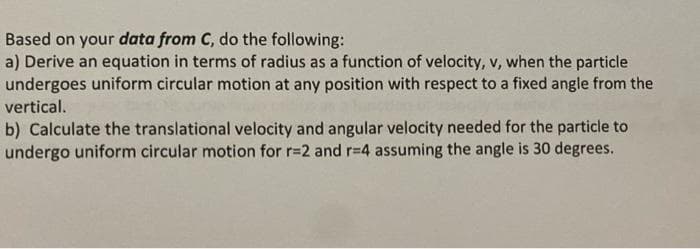Based on your data from C, do the following: a) Derive an equation in terms of radius as a function of velocity, v, when the particle undergoes uniform circular motion at any position with respect to a fixed angle from the vertical. b) Calculate the translational velocity and angular velocity needed for the particle to undergo uniform circular motion for r=2 and r-D4 assuming the angle is 30 degrees.
Based on your data from C, do the following: a) Derive an equation in terms of radius as a function of velocity, v, when the particle undergoes uniform circular motion at any position with respect to a fixed angle from the vertical. b) Calculate the translational velocity and angular velocity needed for the particle to undergo uniform circular motion for r=2 and r-D4 assuming the angle is 30 degrees.
Related questions
Question
3

Transcribed Image Text:Data C
Trial
UCM
Radius, r
Time for
Velocity, v
Rotations, t
2.90
3.94
4,74
5.39
6.67
1.
2.
2.38
3.37
4.12
4.16
S.83
4.

Transcribed Image Text:Based on your data from C, do the following:
a) Derive an equation in terms of radius as a function of velocity, v, when the particle
undergoes uniform circular motion at any position with respect to a fixed angle from the
vertical.
b) Calculate the translational velocity and angular velocity needed for the particle to
undergo uniform circular motion for r=2 and r-4 assuming the angle is 30 degrees.
Expert Solution
This question has been solved!
Explore an expertly crafted, step-by-step solution for a thorough understanding of key concepts.
This is a popular solution!
Trending now
This is a popular solution!
Step by step
Solved in 2 steps with 2 images
